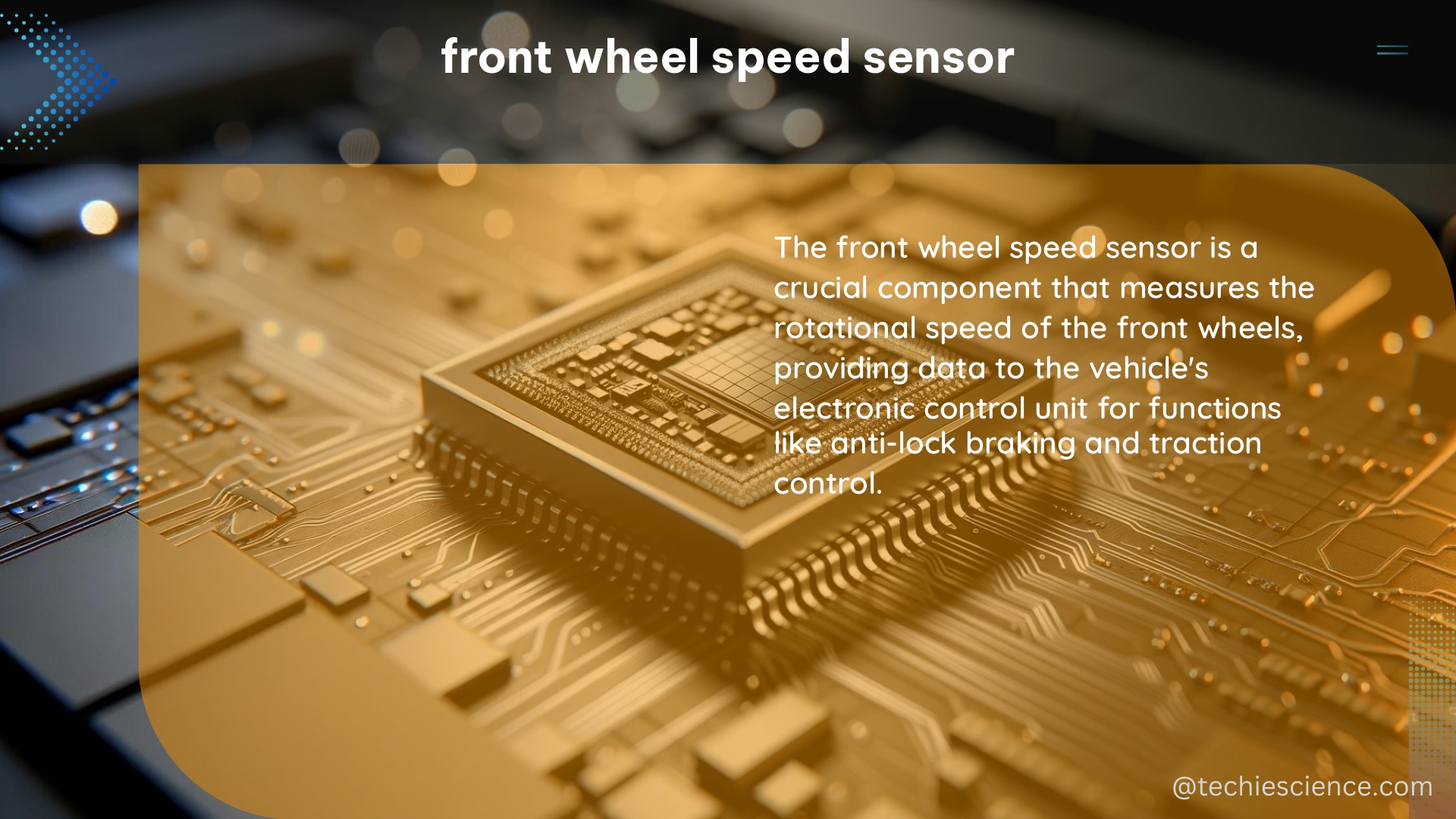The front wheel speed sensor, also known as the ABS sensor, is a critical component in a vehicle’s anti-lock braking system (ABS) that measures the rotational speed of the wheel. This data is essential for the ABS to function correctly, preventing the wheels from locking up during hard braking, thereby maintaining vehicle stability and control.
Technical Specifications of Front Wheel Speed Sensors
Sensor Types
Front wheel speed sensors can be of two types – active or passive:
-
Active Sensors: These sensors have integrated electronics and are supplied with a defined voltage from the ABS control unit, typically ranging from 8 to 12 volts DC. The sensor’s output signal is a digital square wave with a frequency proportional to the wheel speed.
-
Passive Sensors: These sensors do not require a separate power supply from the control unit and generate an output signal when a supply voltage is applied. The output signal is an alternating current (AC) sine wave, with the frequency and amplitude proportional to the wheel speed.
Sensor Positioning
Front wheel speed sensors are positioned directly above the impulse wheel, which is connected to the wheel hub or drive shaft. The sensor detects the changing magnetic field induced by the rotation of the impulse wheel, which is in relation to the wheel speed.
The impulse wheel is typically made of a ferromagnetic material, such as steel, and has a series of evenly spaced teeth or slots that create a varying magnetic field as the wheel rotates. The sensor, which is usually a Hall-effect or inductive sensor, converts this magnetic field variation into an electrical signal.
Signal Processing
The wheel speed sensors convert the sinusoidal signal into a digital signal, which is then transmitted to the control unit as a current signal using the pulse-width modulation (PWM) method. The sensor is connected to the control unit via a two-pole electric connecting cable, with the sensor signal transmitted over a power supply line and a sensor ground line.
The control unit processes the digital signal from the sensor to determine the wheel speed, which is then used to control the ABS system. The control unit monitors the relative speeds of the wheels and applies individual brake pressure to prevent wheel lockup during hard braking.
Frequency and Amplitudes
The frequency and amplitudes of the alternating voltage induced in the winding of a passive sensor are in relation to the wheel speed. Inductive-passive sensors do not require a separate power supply from the control unit, and the amplitude level must be within a specific voltage range, typically between 0.2 and 12 volts.
For example, a passive sensor with a 60-tooth impulse wheel rotating at 60 rpm would generate a sinusoidal signal with a frequency of 60 Hz (60 teeth x 60 rpm / 60 seconds per minute) and an amplitude of around 1 volt.
DIY for Front Wheel Speed Sensor Replacement

To replace a faulty front wheel speed sensor, follow these steps:
-
Locate the Sensor: The front wheel speed sensor is usually located near the wheel hub or drive shaft. Refer to the vehicle’s service manual for the exact location, as the positioning may vary depending on the make, model, and year of the vehicle.
-
Remove the Wheel: Jack up the vehicle and remove the wheel to access the sensor.
-
Disconnect the Electrical Connector: Unplug the electrical connector from the sensor. This may require the use of a specialized tool or a gentle prying motion to release the connector.
-
Remove the Sensor: Use a sensor socket or a wrench to remove the sensor from the wheel hub or drive shaft. Be careful not to damage the sensor or the surrounding components during the removal process.
-
Install the New Sensor: Install the new sensor in the reverse order of removal. Make sure to tighten it to the specified torque, which can typically range from 8 to 20 Nm, depending on the vehicle.
-
Reconnect the Electrical Connector: Plug in the electrical connector to the new sensor, ensuring a secure connection.
-
Test the Sensor: Start the vehicle and test the sensor by checking the ABS warning light on the dashboard. If the light is off, the sensor is functioning correctly. If the light remains on or flashes, there may be an issue with the sensor or the ABS system that requires further diagnosis.
It’s important to note that the replacement process may vary slightly depending on the specific vehicle, and it’s always recommended to refer to the manufacturer’s service manual for detailed instructions and specifications.
References
- How to get ABS LIVE DATA from your car in 2 minutes – YouTube
- ABS wheel speed sensor – measuring vehicle speed – Arduino Forum
- BRAKE DISCS AND WHEEL SPEED SENSORS IN ABS SYSTEMS – HELLA PAGID
- Check and change ABS and wheel speed sensors – HELLA
- Front wheel speed sensors – TrailVoy

The lambdageeks.com Core SME Team is a group of experienced subject matter experts from diverse scientific and technical fields including Physics, Chemistry, Technology,Electronics & Electrical Engineering, Automotive, Mechanical Engineering. Our team collaborates to create high-quality, well-researched articles on a wide range of science and technology topics for the lambdageeks.com website.
All Our Senior SME are having more than 7 Years of experience in the respective fields . They are either Working Industry Professionals or assocaited With different Universities. Refer Our Authors Page to get to know About our Core SMEs.